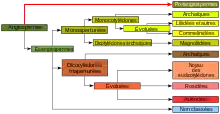Hydatellaceae
La famille des Hydatellacées est une petite famille (anciennement) de plantes monocotylédones.

| Règne | Plantae |
|---|---|
| Sous-règne | Tracheobionta |
| Division | Magnoliophyta |
| Classe | Liliopsida |
| Sous-classe | Commelinidae |
| Ordre | Hydatellales |

Ce sont des plantes herbacées, annuelles, à rosette, aquatiques avec des feuilles submergées et émergentes, autogames ou à pollinisation aquatique, de Nouvelle-Zélande et de l'ouest de l'Australie.
Étymologie
Le nom vient du genre Hydatella lui-même issu de Hydat (eau, ampoule pleine d'eau) et du suffixe latin -ella (petite)[1].
Classification
La classification phylogénétique APG (1998)[2] et classification phylogénétique APG II (2003)[3] assignent cette famille à l'ordre Poales, placé sous Angiospermes→Monocotylédones→Commelinidées.
Mais le Angiosperm Phylogeny Website [] assigne cette famille dans l'ordre Nymphaeales, placé directement sous Angiospermes.
En classification phylogénétique APG III (2009)[4] cette famille est placée dans l'ordre Nymphaeales.
Liste des genres
Selon World Checklist of Selected Plant Families (WCSP) (16 mai 2010)[5] et NCBI (16 mai 2010)[6] :
- genre Trithuria Hook.f. (1858)
Selon Angiosperm Phylogeny Website (16 mai 2010)[7] et DELTA Angio (16 mai 2010)[8] :
- genre Hydatella Diels
- genre Trithuria Hook.f.
Liste des espèces
Selon World Checklist of Selected Plant Families (WCSP) (27 mars 2010)[9] :
- genre Trithuria Hook.f. (1858)
- Trithuria austinensis D.D.Sokoloff, Remizowa, T.D.Macfarl. & Rudall (2008)
- Trithuria australis (Diels) D.D.Sokoloff, Remizowa, T.D.Macfarl. & Rudall (2008)
- Trithuria bibracteata Stapf ex D.A.Cooke (1981 publ. 1983)
- Trithuria cookeana D.D.Sokoloff, Remizowa, T.D.Macfarl. & Rudall (2008)
- Trithuria cowieana D.D.Sokoloff, Remizowa, T.D.Macfarl. & Rudall (2008)
- Trithuria filamentosa Rodway (1903)
- Trithuria inconspicua Cheeseman (1906)
- Trithuria konkanensis S.R.Yadav & Janarth. (1994)
- Trithuria lanterna D.A.Cooke (1981)
- Trithuria occidentalis Benth. (1878)
- Trithuria polybracteata D.A.Cooke ex D.D.Sokoloff, Remizowa, T.D.Macfarl. & Rudall (2008)
- Trithuria submersa Hook.f. (1858)
Note: Kew Garden place toutes les espèces Hydatella sp. dans Trithuria.
Selon NCBI (27 mars 2010)[10] :
- genre Trithuria
- Trithuria filamentosa
- Trithuria inconspicua
- Trithuria submersa
Notes et références
- André Cailleux et Jean Komorn, Dictionnaire des racines scientifiques : 3ème édition revue et augmentée de plus de 1200 entrée nouvelles, Paris, SEDES-CDU, , 264 p. (ISBN 2-7181-3708-8), p. 94, 126
- (en) Angiosperm Phylogeny Group, « An ordinal classification for the families of flowering plants », Annals of the Missouri Botanical Garden, Jardin botanique du Missouri, vol. 85, no 4, , p. 531–553 (ISSN 0026-6493, 2162-4372, 0893-3243 et 2326-487X, DOI 10.2307/2992015, JSTOR 2992015, lire en ligne)
- (en) Angiosperm Phylogeny Group, « An update of the Angiosperm Phylogeny Group classification for the orders and families of flowering plants: APG II », Botanical Journal of the Linnean Society, Wiley-Blackwell, Linnean Society of London et OUP, vol. 141, no 4, , p. 399–436 (ISSN 0024-4074 et 1095-8339, DOI 10.1046/J.1095-8339.2003.T01-1-00158.X)
- (en) Angiosperm Phylogeny Group, « An update of the Angiosperm Phylogeny Group classification for the orders and families of flowering plants: APG III », Botanical Journal of the Linnean Society, Wiley-Blackwell, Linnean Society of London et OUP, vol. 161, no 2, , p. 105–121 (ISSN 0024-4074 et 1095-8339, DOI 10.1111/J.1095-8339.2009.00996.X)
- WCSP. World Checklist of Selected Plant Families. Facilitated by the Royal Botanic Gardens, Kew. Published on the Internet ; http://wcsp.science.kew.org/, consulté le 16 mai 2010
- NCBI, consulté le 16 mai 2010
- Stevens, P. F. (2001 onwards). Angiosperm Phylogeny Website. Version 14, July 2017 [and more or less continuously updated since]." will do. http://www.mobot.org/MOBOT/research/APweb/, consulté le 16 mai 2010
- DELTA Angio, consulté le 16 mai 2010
- WCSP. World Checklist of Selected Plant Families. Facilitated by the Royal Botanic Gardens, Kew. Published on the Internet ; http://wcsp.science.kew.org/, consulté le 27 mars 2010
- NCBI, consulté le 27 mars 2010
Liens externes
- (en) Référence Kew Garden World Checklist : Hydatellaceae
- (en) Référence Angiosperm Phylogeny Website : Hydatellaceae ()
- (en) Référence DELTA Angio : Hydatellaceae Hamann
- Voir aussi Centrolepidaceae
- (en) Référence Catalogue of Life : Hydatellaceae U. Hamann (consulté le )
- (en) Référence Paleobiology Database : Hydatellaceae Hamann
- (en) Référence NCBI : Hydatellaceae (taxons inclus)
- (en) Référence GRIN : famille Hydatellaceae U. Hamann (+liste des genres contenant des synonymes)
- (en) Référence FloraBase (Australie-Occidentale) : classification Hydatellaceae